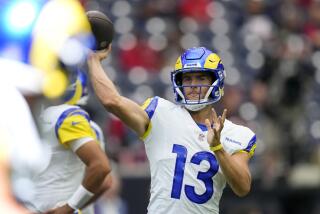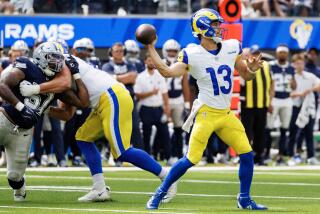Pro Football / Bob Oates : Rams’ Green Hasn’t Been Much of a Prize
- Share via
People are beginning to talk about Gaston Green, the running back from UCLA who became the No. 1 draft choice of the Rams last April.
In the scouting departments of some National Football League teams, they’re saying that Green doesn’t look like a No. 1 draft choice.
They’re saying that because Green represents the key first prize for the Rams in the Eric Dickerson trade, the Rams need a few big games from the former Bruin star to make the most of that trade.
Instead, Green gained 1 yard in 1 carry Sunday in New Orleans, continuing a nonproductive season.
Since July, Ram Coach John Robinson has said, in effect, that Green is coming along.
Some considerations:
--Running back is the one position at which rookies usually produce immediately in pro football, if they have NFL talent. No pro position is easy to play, but running back is the easiest, much simpler than, for instance, offensive tackle. That’s why Bo Jackson could be an instant Raider starter.
--Dickerson gained more than 1,000 yards as a rookie. So have other good backs.
--Though a rookie, Green has been around awhile. Counting exhibitions, this week’s game at Philadelphia will be his 15th pro game. There was a time when the entire NFL season wasn’t that long.
--Green has had the benefit of probably the best coaching in the league from Robinson, who, as a tutor of running backs, has been considered one of the best in both college and pro ball for many years.
Green has the speed to break one on a kickoff someday. But so far, there has been a wide difference between him and Dickerson on runs from scrimmage.
One reason the 4-5 Indianapolis Colts are having trouble this season was apparent Monday night, when, facing Denver, they often attacked from the college wishbone formation.
“Pros who spend time practicing wishbone ground plays instead of NFL pass plays can’t be expected to have enough pass offense,” said Sid Gillman, a former NFL coach.
And the Colts don’t.
They had 4 touchdowns from Dickerson, true, but as a team, the Colts are like the Rams when Dickerson was here. First the Rams and now the Colts are proving that you can’t run your way into the Super Bowl.
It’s a lesson that Robinson has learned and that Colt Coach Ron Meyer hasn’t.
Because Dickerson is 5 or 6 years older than many of the other players involved in the big trade, he probably will be out of football when some of them are still playing.
And then you will hear that the Colts were the big loser in the Dickerson trade.
But the Colts would have been the big winner if they had simultaneously developed a reasonably effective pass offense.
The way Dickerson ran Monday night, it was obvious that if the Rams still had him and Jim Everett, too, they’d be the class of the NFL.
The Dickerson trade--and the frugality of the Rams in making it--can only be seen properly in that light.
Two West Coast teams changed quarterbacks Sunday and came away winners, the Raiders over Kansas City with Steve Beuerlein, and San Francisco over Minnesota with Steve Young.
“You don’t want to give up on Jay Schroeder down there,” 49er Coach Bill Walsh said. “His problem is simply that it takes a lot of grooming, a lot of exposure to the system to make a quarterback.
“Schroeder and Steve Beuerlein are both good passers, but (the Raiders) have spent more time grooving Beuerlein.”
Young’s 49-yard touchdown run that beat the Vikings was the most artistic of the week, better than any of Dickerson’s.
“I think (Young) may be the fastest quarterback to ever play in the T-formation,” Walsh said.
For Raider fans, the encouraging thing about Beuerlein was that he passed to wide receivers for 15 of his 18 completions. Many passers beef up their statistics with short throws to running backs.
Finding a wide receiver down the field a few yards in the maze of an NFL pass defense is much harder.
It seemed to prove that Beuerlein was reading the Kansas City secondary, and reading it right.
For a quarterback who had never been in an NFL game until this season, that was impressive.
So was Beuerlein’s scramble on one of the game’s key plays. Many pro scouts have correctly criticized Beuerlein as slow and lacking agility, but those qualities mean something different in a quarterback.
Nobody expects quarterbacks to have a halfback’s agility. What they need most on scramble plays is a sense of timing. Beuerlein took off at precisely the right time.
Two more NFL quarterbacks went down with injuries Sunday, Jim McMahon of Chicago and Rusty Hilger of Detroit, and their teams both lost.
To Rick Korch, associate editor of Pro Football Weekly, the long 1988 injury report brings to mind the day that a boy and his father saw their first game together:
Son: “Say, Dad, why is he called a quarterback?”
Dad: “Because he lasts about a quarter before he gets injured.”
Hilger, as it happened, lasted longer than that this week, but his concussion eventually cost the Lions. They lost in overtime when his replacement messed up a handoff. The New York Giants recovered in field goal range and won, 13-10.
The loss of McMahon for at least a month would be more harmful to the Bears were it not for a schedule that is filled with breathers against 2-7 Tampa Bay, 2-7 Green Bay and 2-7 Detroit in the weak NFC Central.
In the final 2 months, the Bears will play Tampa Bay before Washington, then Tampa Bay and Green Bay before their Monday night game against the Rams Dec. 5, and then Detroit before playing at Minnesota Dec. 19.
Quote Department:
Russ Thomas, Detroit general manager: “Even when the quarterbacks aren’t getting sacked, they’re still getting pounded.”
Jim Finks, New Orleans general manager: “When you’re sending four or five (receivers) into the patterns, anytime a quarterback so much as hesitates before throwing the ball, he’s going to take a shot.”
Fred Dryer, former Ram defensive star, now starring as a detective on TV’s “Hunter”: “There’s no short side of the field to protect the quarterback anymore. When the hash marks were closer to the sideline, (most) blitzes came from the weak side. Now the blitzes come from all over.”
Bill Parcells, New York Giants coach, on his 5-foot 8-inch, 160-pound receiver, Stephen Baker: “You know, (at the circus) they bring those little cars in, and 18 guys get out. He’d be in that group.”
Gene Stallings, Phoenix coach, on Dallas Coach Tom Landry: “I don’t think he’s lost a thing. I was on the sidelines with him for a long time, and he’s always been well prepared. . . . Unless you’ve experienced being in the heat of battle, you don’t know what it’s like out there.”
Bobb McKittrick, 49er offensive line coach, comparing NFL defensive linemen: “(Chicago’s) Richard Dent has speed enough to beat you. But he won’t take you on and sweep you right back into the quarterback. (Minnesota’s) Chris Doleman can do that.”
Keith Millard, Doleman’s teammate in the Minnesota defensive line: “I’m just a die-hard football player that’s relentless in my pass rush.”


